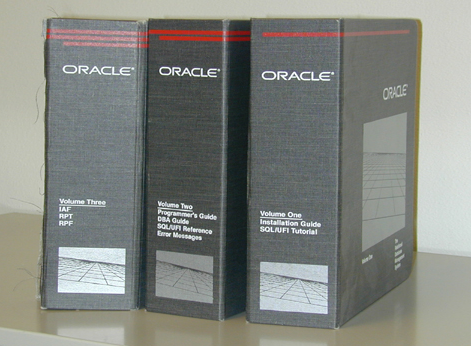Oracle RDBMS version 4.1.4 for RSX-11M+.
Instructions.
It is assumed that the container file is attached in SIMH as rl0.
Create a privileged account, suggested is [4,10] or [ORACLE] if you
want to use a named directory :
create/dir du0:[4,10] or create/dir du0:[ORACLE]
set def du0:[4,10] or set def du0:[ORACLE]
Mount the distribution RL02 pack :
allocate dl0:
mount/public dl0:oraclev4
Copy the code to the system disk :
copy dl0:[4,200]*.* *.*
Unmount the distribution disk :
dismount dl0:
Build the Oracle software :
@orbld
(When the build script asks the device, specify du0:, assuming you are
using either Johnny's or Mark Matlock's disk image on your PiDP-11/70.)
Two scripts are created, 'insoracle.cmd' and 'remoracle.cmd'.
The 'insoracle.cmd' is typically used from lb:[1,2]startup.cmd and
loads the ORACLE sofware into memory. Whereas 'remoracle.cmd' is typically
called from lb:[1,2]shutup.cmd' for an orderly removal of the software
from memory before system shutdown..
Furthermore, a global logical named 'sys$oracle is created and points
towards the install directory.
To make the Oracle HELP file part of the HELP system, edit
lb:[1,1]dcl.hlp and lb:[1,2]mcr.hlp. Add the name 'ORACLE' to the
keyword section, and '1 ORACLE' to the end of the file, followed by
'@ORACLE' on the next line.

Q: When was Oracle V4.1.4 for RSX11M+ released?
A: Early June 1985.
Q: Are there additions compared to the original distribution?
A: Yes. Besides some textual improvements, I also have added a HELP file which
will get installed in LB:[1,1].
You only need to add the reference to it in both LB:[1,1]MCR.HLP and
LB:[1,1]DCL.HLP, as well as an entry in the keyword overview (can be found
in the top part of the DCL/HLP / MCR.HLP file.
Q: Is there a size limit for the SGA?
A: Yes, the total SGA cannot exceed 64Kb period. The parameter file which comes
with the distribution should be however sufficient for general use.
Q: Can I build my own program that works with ORACLE?
A: Yes. The 'High Level Interface' is available and is placed in ocicee.obj.
Use ceetkb.cmd to build your own program with it, see sample.c for some
additional information.
For the C pre-compiler, see samplec.pc for additional information.
Note : Only Whitesmith's C is supported for C based programs.
Q: What is the maximum size of a database?
A: Probably 2Gb, but try it out.
Q: The 'host' command seems to be missing?
A: At the 'UFI>' prompt, use a '$', immediately followed by the command to
be executed, f.e. '$DIR *.UFI'
Q: The AIJ (After Image Journalling) utility seems to be missing. Is that
correct?
A: Yes. The original release notes (see V4SHIP.REL) states that due to bugs,
the AIJ functionality would be fixed in the V4.2 release. I have excluded
it from this distribution.
Q: Can I run multiple instances?
A: No. This is due to the fixed naming used for the SGA.
Q: Does it have network support?
N: No. SQL*Net V1 started with Oracle V5.0.
Q: I'm using a SIMH based PDP11 on a PiDP-11/70, is there a speed difference?
A: Absolutely. Your machine may use a 3GHz+ processor, whereas a real PDPP-11
processor did run at 10 - 20 MHz.
Q: What can i use this software for?
A: That is for you to decide. Maybe a database with cooking recipies,
or an inventory of your vintage computing spare parts?
Q: Which tools are available?
A: Use 'HELP ORACLE' (if MCR.HLP and DCL.HLP are modified) from MCR or DCL.
Q: Is there a V4 documentation set available?
A: 1 - see the question above this one.
2 - if the online help is also loaded into the database, use the 'help'
command when logged in into UFI.
3 - Paper documentation may still exists, but not available to me (yet).
4 - If you happen to have an Oracle V4 for MS-DOS documentation cube,
then 95% of it will be applicable (and let me know!).
Also, much of the Oracle V5.0/5.1 rdbms manual will be compatible
(to an extent) with V4.1.
Q: Which program is / does what?
A: After a sucessful build, you will find the following task files :
BSI.TSK (Basic Sql Interface) - a simplified UFI implementation
CCF.TSK (Create Contiguous File) - to create database files
CRT.TSK (CReate Terminal) - to create the terminal file.
EXP.TSK (EXPort) - to export data
FSF.TSK (FaSt Form) - simplified IAG implementation
IAG.TSK (Interactive Application Generator) - to generate screen apps
IAP.TSK (Interactive Application Processor) - to execute a screen app
IMP.TSK (IMPort) to import previously exported data
IOR.TSK (Initialize ORacle) - to init, start or stop the database
OER.TSK (Oracle ERror) to display the message for a given error code
ODL.TSK (Oracle Data Loader) - to load flat file data
ODS.TSK (Oracle Display System) - to monitor locks, processes and more
ORAFSC.TSK (ORAcle Fixed Statement Cache) - holds the internal SQL
ORAOV1.TSK (ORAcle OVerlay 1) - overlay 1 of the kernel
ORAOV2.TSK (ORAcle OVerlay 2) - overlay 2 of the kernel
ORAOV3.TSK (ORAcle OVerlay 3) - overlay 3 of the kernel
ORAOV4.TSK (ORAcle OVerlay 4) - overlay 4 of the kernel
ORAOV5.TSK (ORAcle OVerlay 5) - overlay 5 of the kernel
ORAROO.TSK (ORAcle ROOt) - root overlay of the kernel
ORL.TSK (ORacle Loader) - loads the kernel into memory
OTS.TSK (Oracle TaSk) - task entrypoint for the kernel
PCC.TSK (PreCompiler) -ORACLE C pre-compile (EXEC SQL commands)
RPF.TSK (RePort Formatter) - to format the input to a specified format
RPT.TSK (RePorT generator) - to generate the RPF output with data
SGADEF.TSK (System Global Area DEFiniton) - common to hold the fixed SGA
SGADMP.TSK (System Global Area DuMP) - show data from the variable SGA part.
SGI.TSK (System Global area Information) - to see the settings for IOR
UFI.TSK (User Friendly Interface) - interactive user tool.